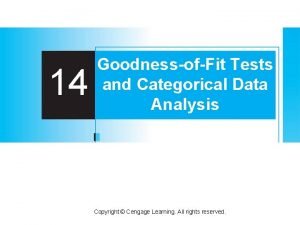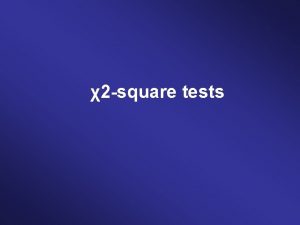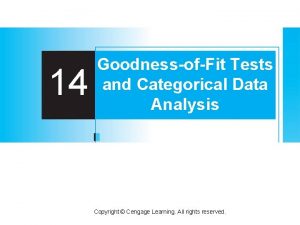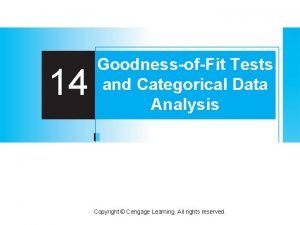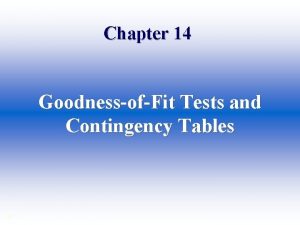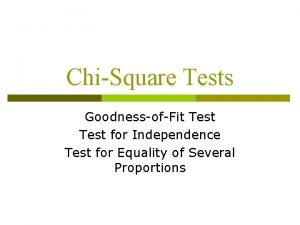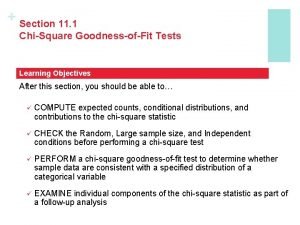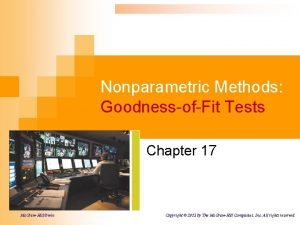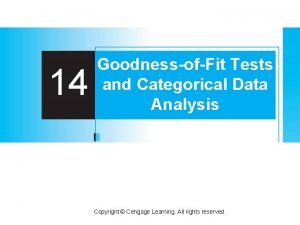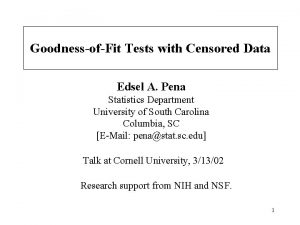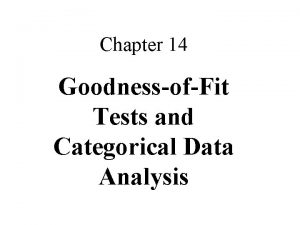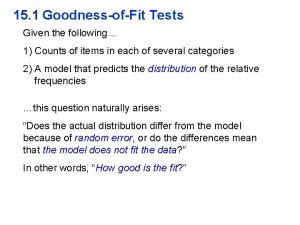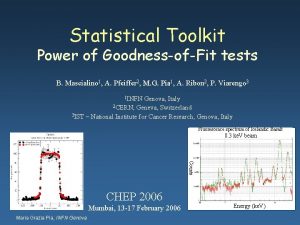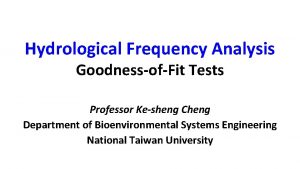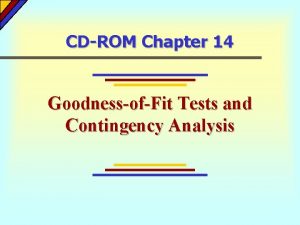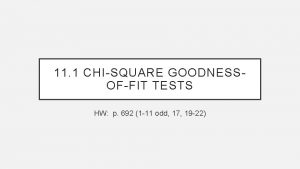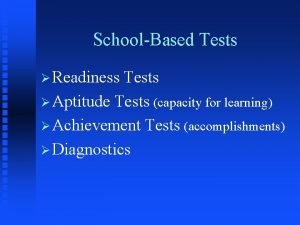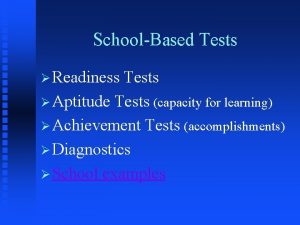A survey of goodnessoffit tests for point process























![In ETAS (Ogata 1998), l(t, x, m) = f(m)[m(x) + ∑i g(t-ti, x-xi, mi)], In ETAS (Ogata 1998), l(t, x, m) = f(m)[m(x) + ∑i g(t-ti, x-xi, mi)],](https://slidetodoc.com/presentation_image_h2/16b491c17beb2875890b5c23bd79ec58/image-24.jpg)








- Slides: 32

A survey of goodness-of-fit tests for point process models for earthquake occurrences Rick Paik Schoenberg, UCLA Statistics • Some point process models in seismology • Pixel-based methods • Numerical summaries • Error diagrams • Residuals: rescaling, thinning, superposition • Comparative methods, tessellation residuals • Example

1. Some point process models in seismology. 2. Point process: random (s-finite) collection of points in some space, S. 3. N(A) = # of points in the set A. S = [0 , T] x X. 4. Simple: No two points at the same time (with probability one). 5. Conditional intensity: l(t, x) = lim. Dt, Dx -> 0 E{N([t, t+Dt) x Bx, Dx) | Ht} / [Dt. Dx]. 6. 7. Dx. Ht = history of N for all times before t, Bx, Dx = ball around x of size * A simple point process is uniquely characterized by l(t, x). (Fishman & Snyder 1976) Poisson process: l(t, x) doesn’t depend on Ht. N(A 1), N(A 2), … , N(Ak) are independent for disjoint Ai, and each Poisson.

Some cluster models of clustering: a) Neyman-Scott process: clusters of points whose centers are formed from a stationary Poisson process. Typically each cluster consists of a fixed integer k of points which are placed uniformly and independently within a ball of radius r around each cluster’s center. b) Cox-Matern process: cluster sizes are random: independent and identically distributed Poisson random variables. c) Thomas process: cluster sizes are Poisson, and the points in each cluster are distributed independently and isotropically according to a Gaussian distribution. d) Hawkes (self-exciting) process: parents are formed from a stationary Poisson process, and each produces a cluster of offspring points, and each of them produces a cluster of further offspring points, etc. l(t, x) = m + ∑ g(t-ti, ||x-xi||). ti < t

Aftershock activity typically follows the modified Omori law (Utsu 1971): g(t) = K/(t+c)p.

Commonly used in seismology: • Stationary (homogeneous) Poisson process: l(t, x) = m. • Inhomogeneous Poisson process: l(t, x) = f(t, x). (deterministic) • ETAS (Epidemic-Type Aftershock Sequence, Ogata 1988, 1998): l(t, x) = m(x) + ∑ g(t - ti, ||x - xi||, mi), ti < t where g(t, x, m) = K exp{am} (t+c)p (x 2 + d)q

2. Pixel-based methods. Compare N(Ai) with ∫A l(t, x) dt dx, on pixels Ai. (Baddeley, Turner, Møller, Hazelton, 2005) Problems: * If pixels are large, lose power. * If pixels are small, residuals are mostly ~ 0, 1. * Smoothing reveals only gross features.

(Baddeley, Turner, Møller, Hazelton, 2005)

3. Numerical summaries. a) Likelihood statistics (LR, AIC, BIC). Log-likelihood = ∑ logl(ti, xi) - ∫ l(t, x) dt dx. b) Second-order statistics. * K-function, L-function (Ripley, 1977) * Weighted K-function (Baddeley, Møller and Waagepetersen 2002, Veen and Schoenberg 2005) * Other weighted 2 nd-order statistics: R/S statistic, correlation integral, fractal dimension (Adelfio and Schoenberg, 2009)


Weighted K-function Usual K-function: K(h) ~ ∑∑i≠j I(|xi - xj| ≤ h), Weight each pair of points according to the estimated intensity at the points: Kw(h) ~ ∑∑i≠j wi wj I(|xi - xj| ≤ h), ^ where wi = l(ti , xi)-1. (asympt. normal, under certain regularity conditions. ) Lw(h) = centered version = √[Kw(h)/π] - h, for R 2

Model: l(x, y; a) = a m(x, y) + (1 - a)n. h (km)

3. Numerical summaries. a) Likelihood statistics (LR, AIC, BIC). Log-likelihood = ∑ logl(ti, xi) - ∫ l(t, x) dt dx. b) Second-order statistics. * K-function, L-function (Ripley, 1977) * Weighted K-function (Baddeley, Møller and Waagepetersen 2002, Veen and Schoenberg 2005) * Other weighted 2 nd-order statistics: R/S statistic, correlation integral, fractal dimension (Adelfio and Schoenberg, 2009) c) Other test statistics (mostly vs. stationary Poisson). TTT, Khamaladze (Andersen et al. 1993) Cramèr-von Mises, K-S test (Heinrich 1991) Higher moment and spectral tests (Davies 1977) Problems: -- Overly simplistic. -- Stationary Poisson not a good null hypothesis (Stark 1997)

4. Error Diagrams Plot (normalized) number of alarms vs. (normalized) number of false negatives (failures to predict). (Molchan 1990; Molchan 1997; Zaliapin & Molchan 2004; Kagan 2009). Similar to ROC curves (Swets 1973). Problems: -- Must focus near axes. [consider relative to given model (Kagan 2009)] -- Does not suggest where model fits poorly.

5. Residuals: rescaling, thinning, superposing Rescaling. (Meyer 1971; Merzbach & Nualart 1986; Nair 1990; Schoenberg 1999; Vere-Jones and Schoenberg 2004): Suppose N is simple. Rescale one coordinate: move each point {ti, xi} to {ti , ∫oxi l(ti, x) dx} [or to {∫oti l(t, xi) dt), xi }]. Then the resulting process is stationary Poisson. Problems: * Irregular boundary, plotting. * Points in transformed space hard to interpret. * For highly clustered processes: boundary effects, loss of power.

Thinning. (Westcott 1976): Suppose N is simple, stationary, & ergodic.

Thinning: Suppose inf l(ti , xi) = b. Keep each point (ti , xi) with probability b / l(ti , xi). Can repeat many times --> many stationary Poisson processes (but not quite ind. !)

Superposition. (Palm 1943): Suppose N is simple & stationary. Then Mk --> stationary Poisson.

Superposition: Suppose sup l(t , x) = c. Superpose N with a simulated Poisson process of rate c - l(t , x). As with thinning, can repeat many times to generate many (non-independent) stationary Poisson processes. Problems with thinning and superposition: Thinning: Low power. If b = inf l(ti , xi) is small, will end up with very few points. Superposition: Low power if c = sup l(ti , xi) is large: most of the residual points will be simulated.

6. Comparative methods, tessellation. -- Can consider difference (between competing models) between residuals over each pixel. Problem: Hard to interpret. If difference = 3, is this because model A overestimated by 3? Or because model B underestimated by 3? Or because model A overestimated by 1 and model B underestimated by 2? Also, when aggregating over pixels, it is possible that a model will predict the correct number of earthquakes, but at the wrong locations and times. -- Better: consider difference between log-likelihoods, in each pixel. (Wong & Schoenberg 2009). Problem: pixel choice is arbitrary, and unequal # of pts per pixel…. .

Problem: pixel choice is arbitrary, and unequal # of pts per pixel…. . -- Alternative: use the Voronoi tessellation of the points as cells. Cell i = {All locations closer to point (xi, yi) than to any other point (xj, yj) }. Now 1 point per cell. If l is locally constant, then cell area ~ Gamma (Hinde and Miles 1980)



8. Example: using focal mechanisms in ETAS
![In ETAS Ogata 1998 lt x m fmmx i gtti xxi mi In ETAS (Ogata 1998), l(t, x, m) = f(m)[m(x) + ∑i g(t-ti, x-xi, mi)],](https://slidetodoc.com/presentation_image_h2/16b491c17beb2875890b5c23bd79ec58/image-24.jpg)
In ETAS (Ogata 1998), l(t, x, m) = f(m)[m(x) + ∑i g(t-ti, x-xi, mi)], where f(m) is exponential, m(x) is estimated by kernel smoothing, and i. e. the spatial triggering component, in polar coordinates, has the form: g(r, q) = (r 2 + d)q. Looking at inter-event distances in Southern California, as a function of the direction qi of the principal axis of the prior event, suggests: g(r, q; qi) = g 1(r) g 2(q - qi | r), where g 1 is the tapered Pareto distribution, and g 2 is the wrapped exponential.

ETAS: no use of focal mechanisms. Summary of principal direction of motion in an earthquake, as well as resulting stress changes and tension/pressure axes.





tapered Pareto / wrapped exp. biv. normal (Ogata 1998) Cauchy/ ellipsoidal (Kagan 1996)

Thinned residuals: Data Cauchy/ ellipsoidal (Kagan 1996) tapered Pareto / wrapped exp. biv. normal (Ogata 1998)

Tapered pareto / wrapped exp. Cauchy / ellipsoidal
 Ace different tests help iq but
Ace different tests help iq but Acls abcde secondary survey
Acls abcde secondary survey Fspos vägledning för kontinuitetshantering
Fspos vägledning för kontinuitetshantering Typiska novell drag
Typiska novell drag Nationell inriktning för artificiell intelligens
Nationell inriktning för artificiell intelligens Vad står k.r.å.k.a.n för
Vad står k.r.å.k.a.n för Varför kallas perioden 1918-1939 för mellankrigstiden?
Varför kallas perioden 1918-1939 för mellankrigstiden? En lathund för arbete med kontinuitetshantering
En lathund för arbete med kontinuitetshantering Särskild löneskatt för pensionskostnader
Särskild löneskatt för pensionskostnader Vilotidsbok
Vilotidsbok Anatomi organ reproduksi
Anatomi organ reproduksi Förklara densitet för barn
Förklara densitet för barn Datorkunskap för nybörjare
Datorkunskap för nybörjare Boverket ka
Boverket ka Debattartikel struktur
Debattartikel struktur Magnetsjukhus
Magnetsjukhus Nyckelkompetenser för livslångt lärande
Nyckelkompetenser för livslångt lärande Påbyggnader för flakfordon
Påbyggnader för flakfordon Formel för lufttryck
Formel för lufttryck Offentlig förvaltning
Offentlig förvaltning I gullregnens månad
I gullregnens månad Presentera för publik crossboss
Presentera för publik crossboss Vad är ett minoritetsspråk
Vad är ett minoritetsspråk Plats för toran ark
Plats för toran ark Treserva lathund
Treserva lathund Epiteltyper
Epiteltyper Claes martinsson
Claes martinsson Cks
Cks Verifikationsplan
Verifikationsplan Mat för idrottare
Mat för idrottare Verktyg för automatisering av utbetalningar
Verktyg för automatisering av utbetalningar Rutin för avvikelsehantering
Rutin för avvikelsehantering Smärtskolan kunskap för livet
Smärtskolan kunskap för livet




































